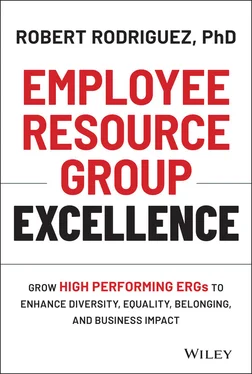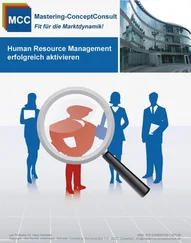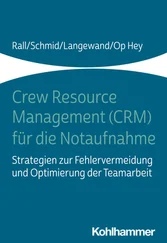More diversity in the workplace calls for leaders who can effectively manage this diversity. Gone are the days when a manager could treat every employee the same way. Today's diverse workforce requires managers to be more inclusive. It requires them to know what motivates each employee and the unique strategies that allow them to get the most out of everyone. Diversity requires managers to use a variety of strategies, approaches, and methods to maximize employee performance. A one‐size‐fits‐all strategy to managing large groups of employees is not effective. Thus, the demand for more inclusive leaders has risen. Employee resource groups help an organization create the more inclusive leaders they need.
Even though organizations have increased diversity overall, employees from historically underrepresented communities are still lacking in most senior leadership teams. Organizations need to do better in grooming executives that come from a more diverse pool of candidates. With their focus on career advancement, ERGs help to create a more representative talent pipeline.
Not only have workplaces become more diverse, so has our society in general. The population growth in the United States is being driven by multicultural communities. The growing size of these minority populations means that their purchasing power is increasing. Thus, companies must cater to a consumer base that is less homogeneous. Multicultural marketing departments have grown in size as organizations look to penetrate previously overlooked market segments. If companies are to leverage diverse markets as a catalyst for economic growth, they need cultural intelligence. Employee resource groups provide this cultural intelligence.
Increasingly, employees want to work for employers that are socially conscious. They want employers who are good corporate citizens in the communities in which they operate. To accomplish this, organizations need employees who are closely connected to their communities. They need employees who want to give back to their neighborhoods, districts, and regions. Organizations also want employees who are involved in local nonprofits because this helps to build bridges with community organizations. Employee resource groups help companies establish stronger relationships in the community.
For these reasons, and many more, organizations need their ERGs to deliver on their goals. We need our ERGs to perform at their peak. And we need organizations to expand their value proposition to all their stakeholders. We are not asking for perfection from our employee resource groups. Perfection is not the goal. The goal is a desire to achieve excellence. The dictionary definition of excellence is “to surpass”; it is “the quality of being outstanding or extremely good.” When ERGs strive for excellence, they are always looking at where they are and how they can get a little bit better. And since we will be discussing the concept of ERG excellence throughout the book, I'm going to define it here at the very beginning of our journey.
As we continue along this book, we will periodically pause to reflect how this definition of ERG excellence came to exist and how it manifests itself in our organizations.
ERG excellence is a commitment to a data‐driven approach, resulting in an inclusively holistic value proposition in which employees drive accelerated career advancement, improved cultural competency, enhanced community relations, and greater company success.
Employee Resource Group Basics
Prior to launching on our journey to ERG excellence, let's take a quick glance at these groups. These groups go by many names, including affinity networks, power of difference communities (PODs), employee networks, and diversity councils. The most common names used to refer to these groups are employee resource groups or business resource groups (BRGs). This book will reference the groups mostly as ERGs and occasionally as BRGs.
So, what are employee resource groups? ERGs are inclusive communities in which the members tend to share some common characteristics. ERGs usually focus on traditionally underrepresented groups within organizations and are typically based on gender (women ERGs), ethnicity (Hispanic ERGs), race (Black/African American ERGs), sexual orientation (LGBTQ ERGs), physical capabilities (disability ERGs), shared experience (military veterans ERGs), age (young professional ERGs), or some other common characteristic (parents ERGs). They typically are formed by employees after receiving the approval by the company to establish an employee resource group.
ERGs are quite prevalent in organizations, with approximately 90 percent of the Fortune 500 companies having employee resource groups. Organizations usually have between six to eight employee resource groups with the occasional company having a dozen or more separate ERGs globally. For example, AT&T, the global media, and communications company, has 37 separate employee groups and networks across their enterprise.
When companies do have ERGs, the minimum penetration rate any organization ought to achieve is 10 percent. This means that at least 10 percent of the organization's employees are members of at least one of their employee resource groups. ERGs can exist with a penetration rate less than 10 percent, but it is difficult for these ERGs to thrive in such situations because they lack the sufficient critical mass of the employee population. A gold standard would be a penetration rate of approximately 20 percent. Best in class numbers that I have seen are a penetration rate of about 40 percent. Just imagine, almost half of an organization's employees identifying as a member of an employee resource group.
The obvious question then becomes, what constitutes being an ERG “member”? Sadly, that is a question that does not have a universally accepted answer. Some companies simply count the number of employees who wish to be placed on an ERG email distribution list as members. Other organizations require employees to formally acknowledge and disclose their membership in an employee resource group through self‐identification. And yet some organizations require a certain level of participation in ERG initiatives before they are counted as a member. This leads to the question of who is considered to be an “active” member. Penetration rates simply use the membership definition chosen by each organization.
My diversity consulting firm, DRR Advisors, conducted a study in 2020 on the average annual investment allocated by companies towards employee resource groups. The study included an analysis of 175 organizations with ERGs and found that the average annual investment allocated to each employee resource group was approximately $8,800 per year for every 100 members. This means that if an employee resource group has 100 members, on average it received an annual budget of $8,800 per year from the company. If an ERG has 200 members, on average it receives an annual budget of $17,600 per year and so on. This represents a 22 percent increase in ERGs budgets since 2011, when ERGs received on average $7,200 per every 100 members, according to a study by the global equality, diversity, and inclusion practice at Mercer. This equates to an average budget increase for employee resource groups of approximately 2.44 percent per year from 2011 to 2020. Personally, I'm aware of one company where the annual budget allocated to just one of their employee resource groups (their women's ERG) is over $1 million per year. A significant investment indeed.
But before we celebrate ERG budget investments, interestingly enough, however, the average annual inflation rate in the United States, according to the US Federal Reserve Bank from 2011 to 2020, is approximately 2.4–2.6 percent. This means that while ERG budgets have increased, these budgets are simply helping ERGs keep up with the inflation rate and thus do not demonstrate any significant progress. So, while organizations have been lauding the importance of their employee resource groups, they have not increased their investment in them over the last decade. ERG excellence hopes to change that.
Читать дальше












